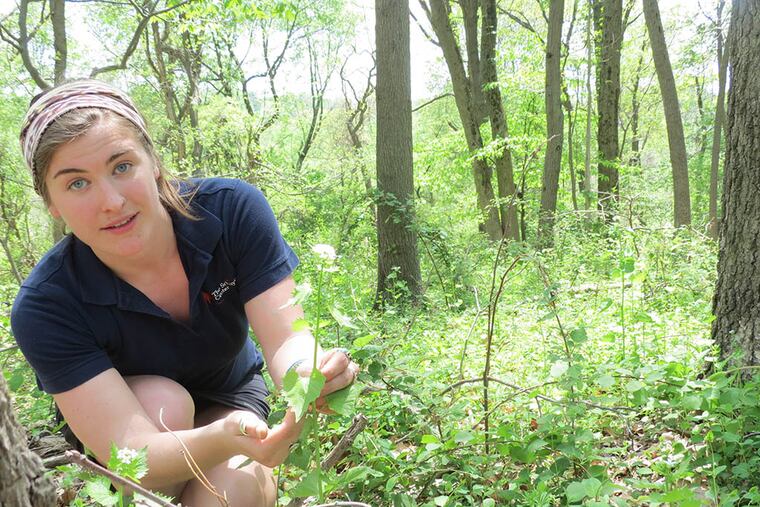Schuylkill nature center brews beer - with weeds
You and I walk through the woods and we see trees and bushes and thorny things. Tess Hooper, a young environmental educator at the Schuylkill Center for Environmental Education, in Upper Roxborough, sees the makings of a fine beer.

YOU AND I walk through the woods and we see trees and bushes and thorny things. Tess Hooper, a young environmental educator at the Schuylkill Center for Environmental Education, in Upper Roxborough, sees the makings of a fine beer.
"This is a staghorn sumac," she said, nodding toward the kind of tree I've seen sprout dozens of times on vacant lots. "It bears these red cones that are like fruit. You could make beer with them."
Hmm . . . I must've missed that merit badge in Boy Scouts.
"Those are stinging nettles. Don't touch them," she said. "They'll really prick you, but if you can gather enough and boil them, the nettles fall off and it makes a nice tea that could add to a beer."
And so it goes on a 20-minute walk with Hooper through the lovely woods in this 340-acre urban oasis on the outskirts of the city. Nearly everything sprouting from the earth, it seems, could be added to beer.
To underscore that point, the center on Saturday will make a one-of-kind beer in its inaugural session of Invasive Brewing. The idea is to hike around the grounds, identify edible plants, forage some potential ingredients and add them to a beer that will be brewed on the premises.
The event is open to the public, and bottles of the finished product will be available when it ferments in about two weeks.
Scavenging for beer, of course, is nothing new. Before man learned how to raise crops of grain and hops, he simply gathered plant life and added it to a mash, hoping it would ferment and turn into alcohol.
What's surprising to me is that there's such a wealth of potential beer ingredients in the midst of a big city.
You know those meandering reddish brambles that grow in the shade? They're called wine berries. They're terribly invasive and strangle other native species when left to their own devices. But their berries are sweet and full of fermentable sugar.
And those 18-inch stems topped with lacelike white flowers? That's garlic mustard, and its leaves, which smell just like mustard, would make a perfect ingredient in a spicy saison.
Dandelions? I mulch 'em with my lawn mower, but Hooper sees those damn yellow flowers and reasons that if they're good enough for wine, they're good enough for beer.
Along a path, she picked the leaf off a tree and held it to my nose. "Smells like Froot Loops, doesn't it?" she said.
"Maybe you could dry-hop a beer with it," I suggested, thinking its aroma would go well with an India pale ale.
"It's sassafras," she replied. "They used to use the roots to make root beer. I imagine you could use it to make beer, too . . .
"Bummer about the carcinogen thing, though."
Say what?
Alas, the U.S. Food and Drug Administration banned sassafras as a food ingredient because one of its chemical oils, called safrole, can cause cancer. (It's also an ingredient in Ecstasy.)
So much for this city boy's nature walk. You can explore the center for yourself during Invasive Brewing at the Schuylkill Center.
You'll learn about edible plants and invasive species in an afternoon session led by Hooper and Home Brewed Events. The program includes a hike, a brewing lesson and samples of Schuylkill Center Invasive Plant Brew.
The event runs from noon to 3:30 p.m. Saturday at the center, 8480 Hagys Mill Road. Tickets are $50, available at schuylkillcenter.org.
About the Schuylkill Center: Founded in 1965, it's the nation's first urban environmental education center, now marking its 50th anniversary with a series of events highlighting its work and its vision for the future.